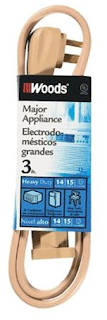
Power tools are tricky. It doesn't help that many manufacturers give horsepower and power requirement ratings based on the motor being unloaded (not doing any useful work, just spinning freely.) The bottom line is, most of us working in residential shops have tripped a breaker operating a power tool (generally a 110v contractor's tablesaw cutting an uncooperative piece of hardwood.) A 1 horsepower motor requires 960 watts of power, which is about 8 amps of power. That is just a bit more than half of the rated 15 amp load of the outlet in the first picture to the left. No problem, right? Well, generally wrong - each circuit at the breaker panel is generally supplying multiple outlets... ...and if you are in a garage or basement shop, probably also the power for whatever overhead light you may have. This becomes clear when you trip a breaker and are left standing in the dark. Plus, if you are running your tools at the ends of long extension cords, the resistance of the cord comes into play, which means that there is less power available to your tool. You can easily figure out exactly how overloaded your circuits are by dividing the watts required for a particular tool (or light or other device) by the voltage (110) to get amperage: A 100 watt lightbulb is 100 divided by 110 giving .9 amps. Add up all the amps being supplied to everything on the same circuit & you have your (over) load. What to do about it?
 First
First, have an electrician add a new 20 amp breaker (or two or five) supplying power to new 20 amp outlets positioned where you need them. Again, calculate the load to determine how many separate circuits you will need. Dust collectors, table saws and any big stationary tools draw the most. Make sure that 12 gauge wire is used, which is a lot thicker than the wire used for 15 amp outlets. Also make sure that your new circuits are separate from any other demand (like lighting) and are dedicated for just your power tools. This way at least you won't be in the dark when you trip a breaker. Your new outlets should look like the one in the second picture to the left. Try and keep each circuit as unloaded as possible. Remember, whatever the breaker is rated for is what it will trip at. Trip a breaker enough times and it will wear out, requiring replacement. Try for around half the load it will trip at. Yep, that means that you'll probably want one outlet with a dedicated breaker for your table saw.
 Second
Second, use the shortest run of the heaviest gauge extension cord that will get the job done. Sure, I have a 50' extension cord of 10 gauge wire for those times when I am really far away from an outlet (or powering a tool from my noisy gas powered generator) but in general, the shortest route to your power is the best. Ideally your outlets will be places so that no extension cord is required, but that is rarely going to be the case. This is where the third picture comes into play - my favorites extensions are short (3, 6 or 12 foot) air conditioner / heavy appliance extension cords. They have a right-angle plug which resists being pulled from the wall accidentally and because they are heavier / have more copper per foot and are short so they lose less juice on the way to your tools. Plus, you won't be tempted to borrow them for times when you need a long extension cord for some other purpose. And because they are short they are cheap enough that you won't mind dedicating a few for your main tools.
I haven't even mentioned what happens when you graduate to a 220v single-phase cabinet saw, but it is much the same as above - only 1 outlet connected to the breaker. I hope this helps the next time you are guiding a piece of wood through your saw and end up standing in the dark. The time to fix that problem is NOW, before it happens again.



1 comment:
Good stuff to think about, Q.
This also applies to power for the recording studio - when we finally get it built - nice clean power is a necessity for good recording. So, I'm going to keep this in mind, and might come back to reread it when we're doing our wiring.
Yes, we've done enough work running our own circuits, and we'll do most of it ourselves. Only hire an electrician for the added circuit breakers in the box, but we've even done that part for ourselves in the past. The best reason for using a professional is that you know there won't be any problems with permits and inspections.
But for folks who haven't worked with wiring and electricity, I wouldn't recommend wiring new circuits as a beginner's DIY project. It's not too difficult, but bring in a friend who knows how. If it's done wrong, the consequences could be burning down the building, or death by electrocution. Scary!
Post a Comment